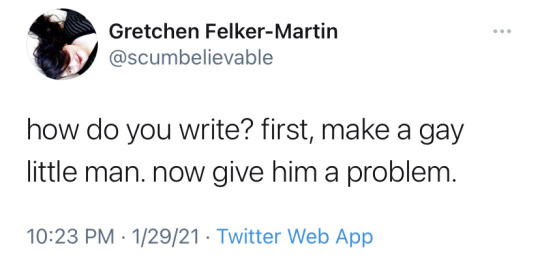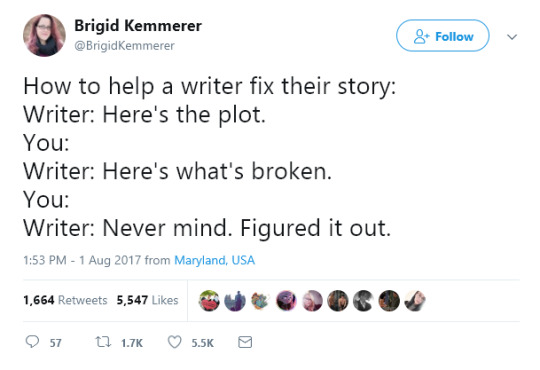ioana. 22. writing sideblog to @alanturingdeservedbetter
Don't wanna be here? Send us removal request.
Text
calling all authors!!
i have just stumbled upon the most beautiful public document i have ever laid eyes on. this also goes for anyone whose pastimes include any sort of character creation. may i present, the HOLY GRAIL:
https://www.fbiic.gov/public/2008/nov/Naming_practice_guide_UK_2006.pdf
this wonderful 88-page piece has step by step breakdowns of how names work in different cultures! i needed to know how to name a Muslim character, it has already helped me SO MUCH and i’ve known about it for all of 15 minutes!! i am thoroughly amazed and i just needed to share with you guys
46K notes
·
View notes
Text
Writer's Guide: Guns
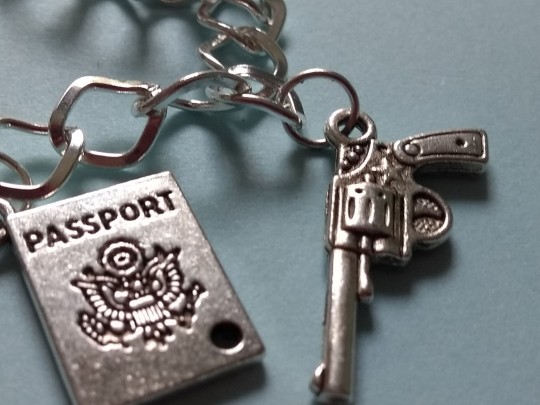
I'm not the biggest fan of guns but I need them in my new WIP. Guns are probably one of the most used tools within most medias, besides being one of the most misused tools. So how can we write them? (my other post on guns focuses on the damage guns can do to a body so go there if that's what your looking for)
Part of a Gun
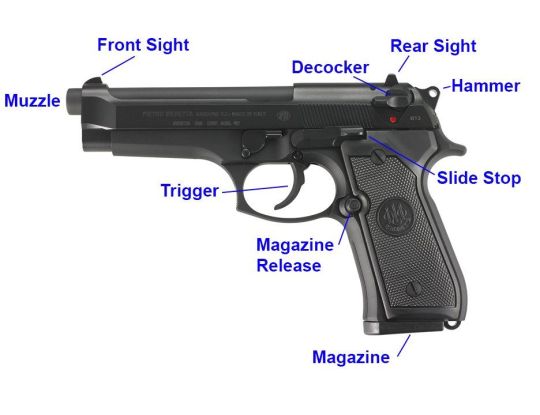
Action: The action is the brain of the gun. It is the part where you load, fire and eject the casings.
Stock: The stock is the handle of the gun. It is made up of the butt and the fore-end.
Barrel: The Barrel is the nose of the gun, the point where the bullets are fired from. Once a bullet is fired, it travels through the barrel and out the muzzle.
Muzzle: the muzzle is the hole the bullet exit from.
Bore: The bore is the inside of the barrel
Cylinder: The Cylinder holds the rounds in a revolver. It rotates as the gun is fired, pumping bullets into the chamber.
Grip: The Grip is where you hold gun.
Hammer: The Hammer on a revolver is a pin like instrument that strikes the primer which fires the bullet from the gun.
Clip: An clip stores the rounds of ammunition on a single line-like device that can be placed into magazine.
Magazine: The Magazine is a container that is spring activated, which can be detachable of fixed. It holds cartridges for a repeating firearm.
Trigger: The Trigger is what you pull yo fire the gun
Trigger Guard: The trigger guard is the loop that fits in front of the trigger to shield it from accidental firing.
Ammunition
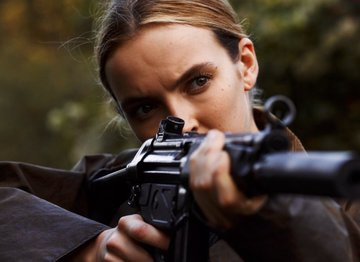
Bullet: is the projectile that exits the gun.
Cartridges/Shell: This is the case, primer, propellant and projectile (bullet). The bullet sits in the cartridge case.
Shotshell: Are rounds of shotgun ammunition, containing pellets rather than a bullet.
Gun Safety

1. Keep the muzzle pointed downwards (not near your feet or others) when not using the gun.
2. Unload gun when not in use
3. Always check the safety.
4. Be sure of your aim. Don't fire blindly because you'll end up wasting bullets and you might hurt somebody
5. If the gun is jammed, don't look down the barrel to see why it's blocked. Point it away from you, open the action and remove the blockage safely.
6. Keep your barrel clean. Any excess cleaning fluid even dirt can mess up your shot or even cause blockages that can burst the barrel
7. Don't alter your gun in any way on your own. Even if you're a self proclaimed expert, don't touch the gun. You can fuck up the intergrity of the weapon.
How to Hold a Handgun
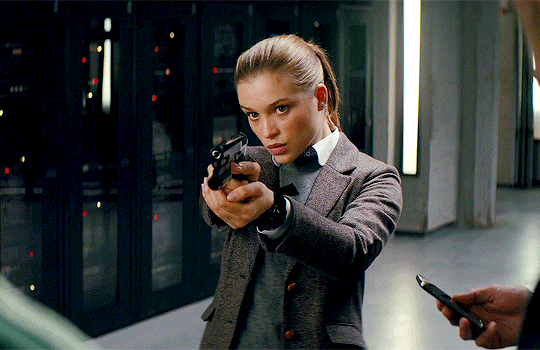
1. Your dominant hand should grip the gun, high along the back strap (back of grip). This will give you better leverage and handle the recoil better.
2. Place your other hand against the other side of the grip. Four fingers should sit snugly under the trigger, while your index finger should rest against the trigger itself.
How to Hande a Rifle/Long barrelled Gun

Hold the rifle with two hands, hold the grip of the rifle with your dominant hand. Your fingers should wrap about the base of the rifle, under the trigger guard.
Your non-dominant hand should be wrapped firmly around the base of the grip. Holding the gun right will help reduce recoil and ensure better control.
How to fire a Gun
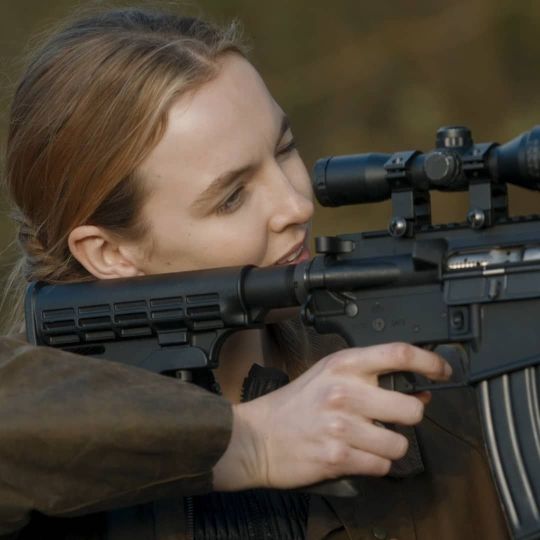
Align your sights. Your gun has a sight at the front and at the rear. Aim and align your sights through these points. There should be equal space between the sights.
Set your sight. When you’re aiming a gun, you’re you are looking through the front sight, the rear sight, and your target. When you're aiming at the target, it will look blurry. The sights should but clear.
Press rather than pull the trigger. You should squeeze it, applying constant pressure until the weapon fires.
Things every Writer should know about Guns
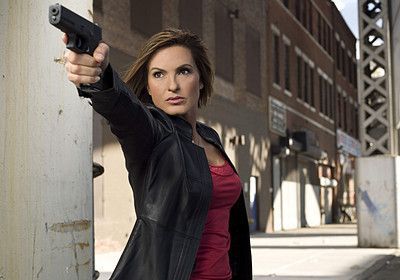
Hollow Point Bullets are not more deadly than full metal jacket bullets. Though a hollow point will cause damage, full metal bullets are actually more likely to over-penetrate and move when with the flesh, causing a more devastating wound.
Guns are really loud. How loud exactly? Most heavy duty guns could cause hearing loss. It simply isn't possible for two characters to have a lovely chat while firing weapons.
Rifles with scopes make it easier to shoot but they won't make a beginner a sudden genius marksman. Scopes help but they don't perform miracles.
Shotguns shoot shells not bullets.
Your character should not tuck a just fired handgun into their waistband or else they will get a nasty burn.
Silencers or better yet, suppressors do not silence your shots. They actually lower the sound by a few decibels.
Don't have your character fire gun sideways. They will fuck up their wrist and look stupid while doing it.
Most rifles and shotguns aren't pump action
If you drop your gun, if won't fire itself.
The clip and magazine are two different things. They can't be used as synonyms.
When somebody is shot, they don't go flying back. They crumple on the spot.
The exit wound of a bullet is larger than the entry point.
Most beginners will have trouble with recoil. Bloody noses and black eyes are common is one doesn't know what their doing.
5K notes
·
View notes
Text
Writer’s Guide: Hand to Hand Combat

Your character is unarmed and all they have left to fight with is their bare hands. If they hope for the enemy to catch their hands, you will have to write an effective scene. So how can we write a good hand to hand combat scene?
Most Common Moves
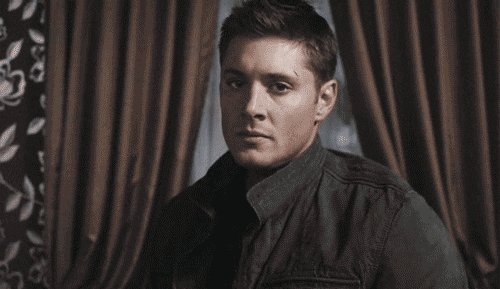
Now, I’m not going to list 30+ martial arts moves. Most of your characters will not be masters of kung fu or mixed martial arts. Most people who get into fights are novices.
Punch: a punch is probably to go to strike. Try not punch anybody in the face because one, they will expect it and two, it will hurt your hand. If you can aim for the soft parts of an opponent, kidneys or gut.
Kick: Kicking isn’t pretty but it is effective. A good swift kick to the back of somebody’s knee will fold them like a lawnchair.
Go for the groin: Man or woman getting kicked in the nether regions is no picnic. A good swift kick with your foot or your knee can incapacitate your opponent. Its not the most honourable of moves but it works.
An Elbow strike is effective: The elbow is your strongest point of attack. Drive it in to a windpipe or a gut and you can but yourself valuable time to retreat or stall your opponent from answering back.
Eyes: they are weak points. Jab somebody in the eyes with a thumb and they will stop in their tracks.
Throat: You can end any fight by going straight for the throat either grasping it in a headlock or jabbing it with a fist which can collapse the windpipe.
Bite: If you are unable to snack your opponent, use your teeth. The human bite is perhaps not as strong as a hyena’s but it is strong enough to shorten your opponent by a finger or two.
How to Escape from Grips and Holds
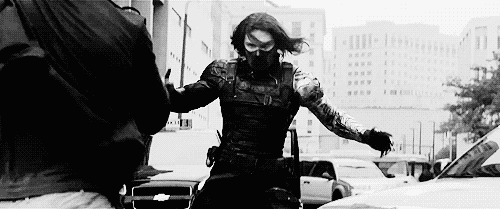
Pinned from behind with your arms pinned: You have to stop your opponent from getting to a headlock. Move your hips to one side and strike backwards toward the groin or gut. This should weaken the hold of your opponent. Once the grip is loosened, turn toward your opponent and snack them into the nose with the heel of your hand.
Held from behind: Bend forward as far as you can making it more difficult for your opponent to lift you. Jab with your elbows back into your opponent’s chest or face. Turn toward your opponent once the grip loosens and strike at the face or the groin again to subdue your opponent.
Headlock: If your opponent has you in a headlock, DON’T STRUGGLE. You could break your own neck. Turn into your opponent’s side as close as possible. With your hand that is furthest away, hit your opponent into the groin or gut.
Pinned down on the ground: Most likely your opponent is using their own hands and weight to keep you down. If you can move your knees, try to jab them in the side or the groin to unbalanced them.
Things to Remember
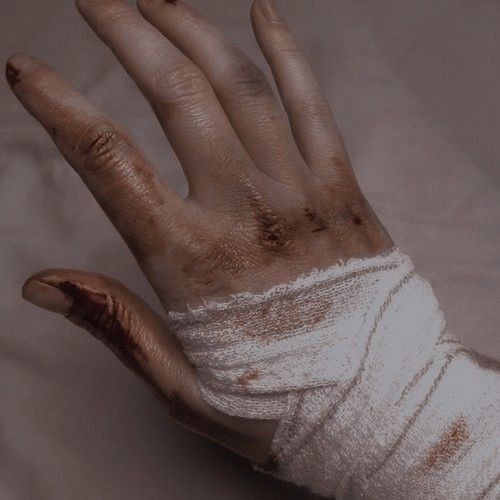
1. The whole 6-10 minute bout only happens in films or controlled sporting events. Fights are usually over within a few minutes. (when writing effective fights, keep the pace short.)
2. Girls are vicious. I’ve worked in nightclubs and broke up a fair few fights. Boys will knock the shit out of each other but girls will tear shreds out of each other. I have known grown men to break up fights between guys but nobody wants to break up a catfight.
3. One wants the fight to end quickly. If you keep slugging at each other, you’ll get tired pretty fast. Have your character try end the fight as soon as possible.
4. Nobody emerges from fights unscathed. Even winners may come out with black eyes, broken noses or at very least a broken lip. If you punch someone, you will likely bruise your knuckles if not split them.
5. If your character is fighting to survive, they don’t have to stick to etiquette. They will have to do anything to survive even if it means doing something unpleasant like fishhooking or hairpulling.
8K notes
·
View notes
Text
5 WAYS TO TELL IF YOU HAVE CHARACTER-PLOT PROBLEMS
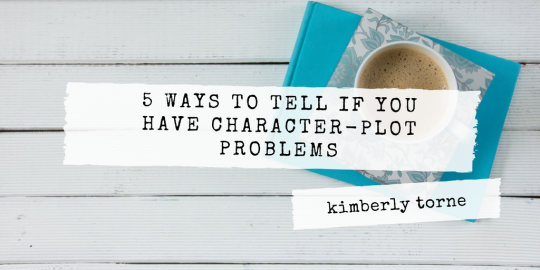
Even if you are writing a plot-driven work of fiction, your characters must be a driving force of change. One of the most common problems I see in regards to both plot and character development are interlinked: characters that don’t change the plot, but only react to what is happening.
1: DOES YOUR CHARACTER DRIVE THE PLOT? OR ARE THEY JUST REACTING TO THE PLOT?
Keep reading
2K notes
·
View notes
Text
Writing Websites
1. a website with a list of superpowers and what they are
2. a website that generates random au ideas
3. a website that generates names, basic info and futures in a bunch of languages
4. a website that checks your grammar
5. website that lists types of execution in the states
6. a website with info on death certificates
7. a website with info on the four manners of death
8. a website with info on the black plague
9. website with information on depression
10. a website with info on the four types of suicide
11. website that lists famous quotes
12. website with different kinds of quotes
13. a website with info on food in every country
14. a website with a list of different colors
15. website with a list of medieval jobs
16. website with a list of fabrics
17. website with a list of flowers and pictures
18. website with a list of flowers and no pictures
19. website with a list of poisonous plants
20. website with a list of poisonous and non-poisonous plants
21. website with a list of things not to feed your animals
22. website with a list of poisons that can be used to kill people
23. website with info on the international date line
24. website with a list of food allergies
25. website with a list of climates
26. website with info on allergic reactions
27. website with info on fahrenheit and celsius
28. website with info on color blindness
29. website with a list of medical equipment
30. website with a list of bugs
31. website with an alphabetic list of bugs and their scientific name
32. website with a list of eye colors
33. website (wikipedia sorry) with list of drinks
34. website with a list of religions
35. website with a list of different types of doctors and what they do
36. website (wikipedia again sorry) with a list of hair colors
37. website that generates fantasy names
38. website with a list of body language
39. website with a list of disabilities
40. website with an alphabetic list of disabilities
44K notes
·
View notes
Text
Please Don’t Write this Sentence in Your Opening
Warning: This post may not be for everyone and may come off as petty.

I regularly read unpublished work. A lot of writers have a cool idea for their protagonist’s backstory, one that is meant to create a sense of mystery for the reader. I love stories like that. I love backstories. I even love a good flashback. But I cannot tell you how many times I’ve read sentences similar to this one in an opening of a story:
Jasper pushed the memories away from his mind.
To the average person, there is nothing wrong with this sentence. But when you read a lot, and you read that sentence a lot, you start realizing the problems in it. There are many variations to this sentence, or at least lead-ins to this sentence. Here are a few others:
Alice used to go the festival every fall with her sister, until her sister got in that accident. Alice shook her head and pushed the thoughts from her mind.
Milly looked at the old photograph and her eyes watered up. Don’t think about it. Don’t think about it, Milly thought. She filed away the memories.
It was a border collie, just like … Adam pushed the thoughts away.
Now before anyone freaks out or protests–I’ve written this sentence before. And there are times where this sentence is fine. But if you write it intentionally in the opening of your story, you should know it’s very cliche and whoever is going through the submission pile has seen it so many times that’s it’s more annoying than mysterious. Besides, there are better alternatives that accomplish the effect these writers are looking for, and I’ll share some of them, after I talk about the problems. Cliche. I already mentioned this, but the thing is, this might sound like a fine sentence, but thousands of other writers thought it was a fine sentence too and so there are loads of stories that have this same sentence. It doesn’t spark curiosity or intrigue in the editors who have read it thousands of times. Some of you might be saying, “Yeah, but there are always going to be sentences like that.” And this is where I say that there are actually other problems with doing this. White Flag. This sentence is a sure warning signal to higher-ups that this writer doesn’t know how to handle backstory on a professional level yet. I know that sounds really weird, because the sentence is punctuated correctly and seems innocent, but it’s not the sentence itself, it’s the fact that experience shows again and again that writers who are still learning how to weave backstory in well, use this sentence. One of the problems with this sentence is that you are drawing attention to the fact that you are withholding important, possibly traumatic, information about your protagonist, and alerting to the reader that “Hey, this is going to be an important backstory that’s kind of mysterious and I’m going to tell you about it later.” It feels a lot less mysterious when the writer is advertising the mystery that way. We’ve all seen this backstory structure in narratives before. We don’t want to be told that it’s the structure you are using, we want to notice that and figure it out for ourselves. Some argue that this sentence is a problem solely because you are hiding important information about the protagonist from your reader, and that if the protagonist is the viewpoint character that the reader should be privy to that important knowledge by default. I actually disagree that it is always bad to withhold important information from the reader, because I believe you can do it, but it’s difficult and takes a lot of talent to do well enough to get away with it. I would argue that the fact the writer is withholding information isn’t so much the problem as the way they are withholding that information. Have you ever talked to someone who is clearly trying to get you to ask a specific question about them? They might say things (out of the blue) like, “Uugh, I can’t believe that happened!” wait a few seconds, then sigh heavily, and follow-up with “Now I’ll never get to do X,” sigh again. And you know they just want you to ask them what’s wrong. This sentence is sort of like that. The writer is broadcasting the fact they are withholding information and signaling to the audience that it will be a mystery that will come out later. They want the reader to ask, “Wow, what was that memory about”? It takes some of the power out of that backstory structure. In this way, it’s kind of similar to writing sentimentally, like a talked about in this post. I touched on this next one earlier, but this sentence is questionable because it seems to contradict the whole “I’m writing in this character’s viewpoint” thing. If the character is reminded of an unfavorable memory, shouldn’t we at least get some kind of flash of said memory? Or some indication as to what it is? I think that’s debatable, but 9 times out of 10, the answer is yes. Now, all this doesn’t mean you have to completely chuck the whole “mysterious backstory” thing, which is the advice you might get from some, usually because most people aren’t conscious of when this is done well. It’s that subtle. And that’s one of the keys to fixing this. Be more subtle. Don’t make the fact that your character is pushing away his bad memories as obvious–don’t tell me that he’s doing it. Get deep in his head and show me instead. Give me a well “told” suggestion of the memory, then show me the character consciously thinking of something else (show me what that something is). Instead of drawing attention to the fact you aren’t telling me about the character’s backstory, put enough in and then draw my attention away from the fact you aren’t telling me. As a reader, I’ll pick up on the fact the character doesn’t want to remember something in his past on my own–which is exactly what needs to happen if I’m meant to feel like it’s a mystery. J.K. Rowling uses this tactic in other forms of mystery in the Harry Potter series. For example, in Prisoner of Azkaban, when Harry, Ron, and Hermione take Scabbers to the pet store, Rowling suggests that there is something odd about Ron’s rat, but almost immediately after, she draws the reader’s attention away from the fact. She doesn’t stay there and point at it with her sentence structure and style. Another similar but different option is to present any suggestion of the suppressed memory as information you are giving, not information you are withholding. Don’t point at the fact you aren’t telling the reader everything to make sure the reader gets there is something more. Drop the hint as information. You can do it in a way that makes the reader curious on her own and makes her wonder about it more. Or you can do it in a way that the reader won’t think twice about until later. You can expand on this information that you as the writer so “generously” gave as you go, until the picture and situation becomes clearer and clearer to the reader. You can use foreshadowing, instead of playing monkey-in-the-middle with your reader. You can drop information in passing. After all, it seems to me that a suppressed memory lives in the subconscious part of your protagonist’s mind, so let it surface, but be subtle about it. And hey, if you’ve already done a good job at cluing me into this suppressed memory and the fact the character doesn’t want to relive it then you can write that sentence, further into the story, and it won’t be annoying, because I’ll know the information behind it, and I’ve already witnessed and decided for myself the character doesn’t want to remember. I know to some this post sounds petty, but really, when you’ve read that sentence as much as I have, you’ve got to do a blog post explaining why it’s annoying and how it can be handled better. And really, some of the stuff I touched on goes beyond that sentence and into how to write mystery itself. Thanks for listening.
2K notes
·
View notes
Text
Power Signalling
Kneeling. (It’s not popular for no reason.) Ordered to kneel as punishment or as a show of deference. Shoved physically to the ground by hands on their shoulders, maybe a kick to the back of the knee. Picking themself up off the ground but only getting as far as hands and knees. Crawling because they haven’t got the strength to stand any more. Dropping to their knees from exhaustion, or despair.
Personal space. Casually invading it. Uninvited touch - from the deeply creepy to something as simple as a firm hand on the shoulder. Standing too close - especially if taller or otherwise physically stronger. Conversely, hurrying to get out of someone’s way.
Eye contact. Staring someone down. Who is first to look away? Averting eyes for one’s social superiors. Insisting that someone maintain eye contact while you’re talking to them. Insisting that someone never look you in the eye. Trying to de-escalate by avoiding eye contact. Singling someone out just by looking at them. Too frightened or ashamed to look someone in the eye.
More generally, attention. The room falls quiet when they walk in. Who cuts in, and who gets talked over. Ignoring those who are beneath your attention. The excited attention given to the object of respect and idolisation. The careful, wary focus given to a potential threat. Deliberately attending to something else to appear less threatening. Deliberately burying oneself in something else to avoid attracting unwanted attention.
Codified status behaviours. Bowing to one’s superiors. Bonus points if there are differentiated kinds of bowing for different status differentials. Soldiers coming to attention when a superior officer comes in. Saluting. Who greets whom first? Serving food in a particular order. Standing up when a respected person enters the room.
Non-verbal threats. Just resting a hand on a weapon, or perhaps even just near a weapon. Cracking knuckles or rolling shoulders. Clenched fists. The little come-get-some-then lift of the chin. Stepping from a conversational stance into one that’s balanced for fight or flight. Pointing a weapon at someone. Casually brushing aside a weapon.
Conversely, de-escalation and surrender. Open hands, spread in front of them. Hands above head. (Raised slowly, transitioning from the simple woah-calm-down gesture to full on surrender as the situation gets tenser.) Going still. Slow, careful movements being sure to keep hands where they can be seen. Laying down weapons. Hands on head. Getting down on the floor. Deliberately making oneself vulnerable to prove non-hostile (or non-resisting) intent.
Alternately, deliberately showing “vulnerability” to demonstrate how little of a threat you consider the other person. The slouch of villainy. Casually putting weapons away or turning one’s back, confident that they won’t do anything. Open posture, casual, relaxed in the face of apparent danger.
Signs of fear. Flinching. Trembling. Closed, defensive posture. Tension. Backing away. Fidgeting. Lip-biting. Arms hugged close to chest. Or refusing to lower defences. Checking for escape routes. Trying to insist that they don’t come any closer.
Offers of or requests for help. Extending a hand to help someone up off the ground. Reaching out a hand in a silent plea. Do they have to ask for help? Are they willing to accept it? Do they get a choice? Who has plenty and who has to rely on the other’s goodwill? Picking someone up off the ground. Carrying them. (Dropping them?) Adjusting someone’s clothes. Withholding aid.
8K notes
·
View notes
Text
me: how many words have i written
is it a million
is it TWO million
word counter: 409 words
me: LIES
430K notes
·
View notes
Text
There’s a trope known as “What You Are In The Dark”, and it’s really useful for showing your audience what kind of person a character is.
It’s essentially where a character, usually- but not always- the protagonist, is in a uniquely tempting situation. They have the opportunity to do something they want to do, something that’s selfish and usually, objectively wrong. They WANT to do it on some level, it’s a benefit, and there won’t be any negative consequences for them. And the cherry on top: Nobody who’s opinion they care about will ever know what they’ve done.
Sometimes, it’s something like not saving someone who was horrible to you. Sometimes it’s a little more active, like an alter ego they can use to express their desires. But it’s always, metaphorically speaking, “in the dark”. Nobody sees, or anyone that sees doesn’t know it’s them, or nobody they care about sees and knows it’s them.
What the character does in that situation tells the audience who that character really is. What they’re like under any facades or pleasantries they may put up. What you are in the dark defines you. You are at your most YOU when nobody is looking.
Usually, if the character is a hero, they’ll throw away this opportunity. They’ll face the little voice whispering, “No one will ever know,” and tell it, “I’LL know.” Because they know whatever they have the chance to do is wrong, and they know they’d be torn up about it. Even with no external restrictions, there’s a little guiding force telling them to do good, or at the very least, NOT do evil.
If the character takes the opportunity to do something bad when no one is looking, they’re not a good person.
And yes, this trope CAN be invoked accidentally.
6K notes
·
View notes
Text
A Complete Beginner’s Guide to Moodboards
Please note that this is a guide for complete beginners who have no idea how to get started on making moodboards. Only the very basics will be covered here.
Have you ever wanted to make a moodboard but didn’t know where to start? You have ideas but you have never edited a picture before? Can’t afford photoshop and don’t know how to use it? Look here, this guide is for you!
This guide includes: Free photoshop alternatives, where to find images, and basic tips and tricks to make your moodboard. Click the Read More below :)
Keep reading
623 notes
·
View notes
Text
tricky words I always see misspelled in fics: a guide
Viscous/vicious – Viscous is generally used to describe the consistency of blood or other thick liquids. Vicious is used to describe something or someone who is violent.
Piqued/Peaked/Peeked – To pique someone’s interest is to catch or tease their attention. When something peaks, it reaches its total height or intensity. To peek (at) something is to look briefly, or glance.
Discrete/Discreet – this is a tough one. Discrete means to be separate, or distinct, i.e., two discrete theories. Conversely, when someone is discreet, they are being secretive or cautious to avoid attention.
Segue/Segway – one is a transition between things, the other is a thing you can ride at the park and definitely fall off of.
Conscious/Conscience/Conscientious – to be conscious is to be awake, i.e., not unconscious, or to be aware of something. Your conscience is the little voice in your head telling you not to eat the entire pint of ice cream. Finally, to be conscientious is to be good, to do things thoroughly, to be ruled by an inner moral code.
Hope this helped! Please add more if you think of them!
50K notes
·
View notes
Note
How do I come up with a gripping title for my book?
10 Ways to Craft a Gripping Book Title
Everyone knows you want a book title that’s unique, gripping, memorable, and relevant, but how do you craft a title that meets those criteria? Here are some tips…
#1 Look at Other Titles in Your Genre - This should be the first step, really, because different genres can have their own common title styles. For example, mysteries and thrillers often contain words like murder or death, or vague character references like “the woman” or “the man who…” Knowing what’s popular in your genre gets your brainstorming session off on the right foot.
#2 Make a List of Story Keywords - Your story’s keywords are an important tool for promoting and marketing your book, but one of the first places they come in handy is when you’re brainstorming titles. If you had to boil your book down to a list of relevant words, what would they be? For Harry Potter , some keywords might be magic, wizardry, wizards, muggles, potions, spells, transfiguration, patronus, dark magic, etc.
#3 Look at the Text of Your Story - Sometimes, the title of your story is a phrase that exists in your story. For example, maybe your protagonist’s grandmother always tells him he’s brighter than he looks. Brighter Than I Look could be a good title.
#4 Consider Famous Sayings - Are there any famous phases, mottoes, idioms, nursery rhymes, etc. that fit your story in any way? Ken Kesey’s book One Flew Over the Cuckoo’s Nest uses a line from a nursery rhyme as a title. Not only are birds a powerful symbol in the story, but the rhyme’s reference to “flight” offers a clue to something that will happen in the story, too.
#5 Look at Your Story’s Opposing Themes, Subjects, or Forces - Every story revolves around conflict. A good force versus an evil force, one mindset against another mindset, one entity against another entity. Angles Versus Demons, Pride & Prejudice, North and South, The Blue and the Gray.
#6 Descriptive Imagery Makes Great Titles - Is there a particularly relevant moment in your story where there’s memorable descriptive imagery? For example, maybe after the inciting incident, your character hikes out to his favorite spot called Hester’s Brook, and while he’s there it begins to snow. Snowfall at Hester’s Brook could be a good title.
#7 Who, What, Where, When - Who is your story about? (Emma, The Raven Boys, Six of Crows.) What is your story about? (The Hunger Games, The Scorpio Races, Looking for Alaska.) Where does your story take place? (Wuthering Heights, Northanger Abbey, The Hazel Wood.) When does your story take place? (Love in the Time of Cholera, April Morning, The Winds of War.)
#8 The Big Question - Sometimes, the big question of the story provides an interesting title. For example, maybe the inciting incident of your story is the moment when the protagonist sees a mysterious man watching her in a crowd, and finding out who he is represents the big mystery of the story. Blue Eyes in a Crowd could be your title.
#9 The Big Answer - Depending on the big question of your story, you can sometimes even work the answer into the title. Maybe the blue-eyed man turns out to be the protagonist’s father who went missing decades earlier. The title could be Memories of a Forgotten Father.
#10 Look for Title Formulas - As a last resort, Google “book title formula” and quite often you’ll find specific formulas people have come up with for titles. These tend to lead to things like The ____ in the _____. Or _____ of the _____ _______, and as such they can be, well, formulaic. Those kinds of titles have been so trendy that they’re bordering on cliche, but for some books that’s exactly the title you need. These formulas work with your story’s keywords to come up with a catchy title, so if none of the other options work, this one is worth a try.
Best of luck coming up with your title!
•••••••••••••••••••••••••••••••••
Have a writing question? My inbox is always open!
Visit my FAQ
See my Master List of Top Posts
Go to my Ko-Fi to buy me a coffee or commission my services! ♥
267 notes
·
View notes











